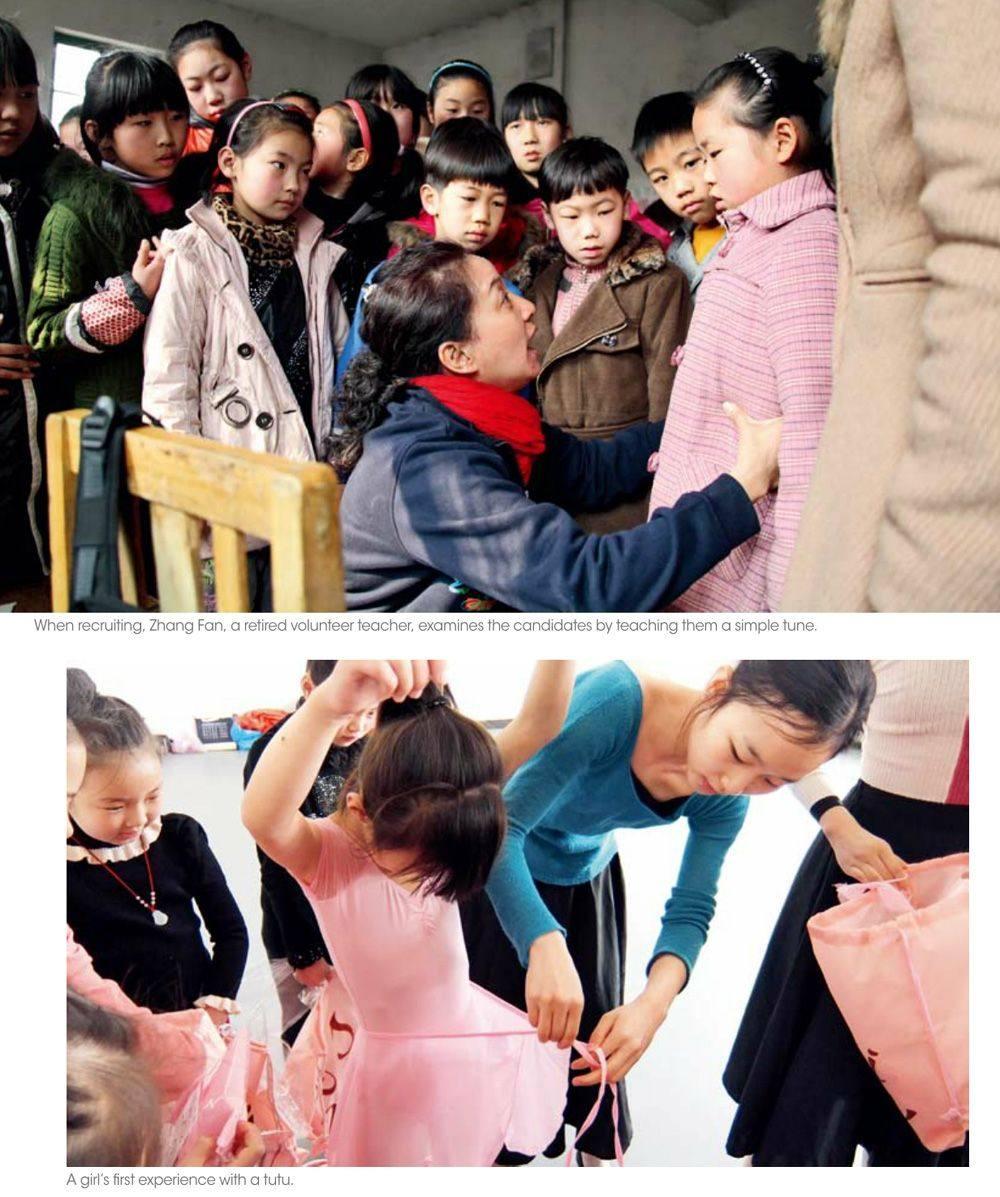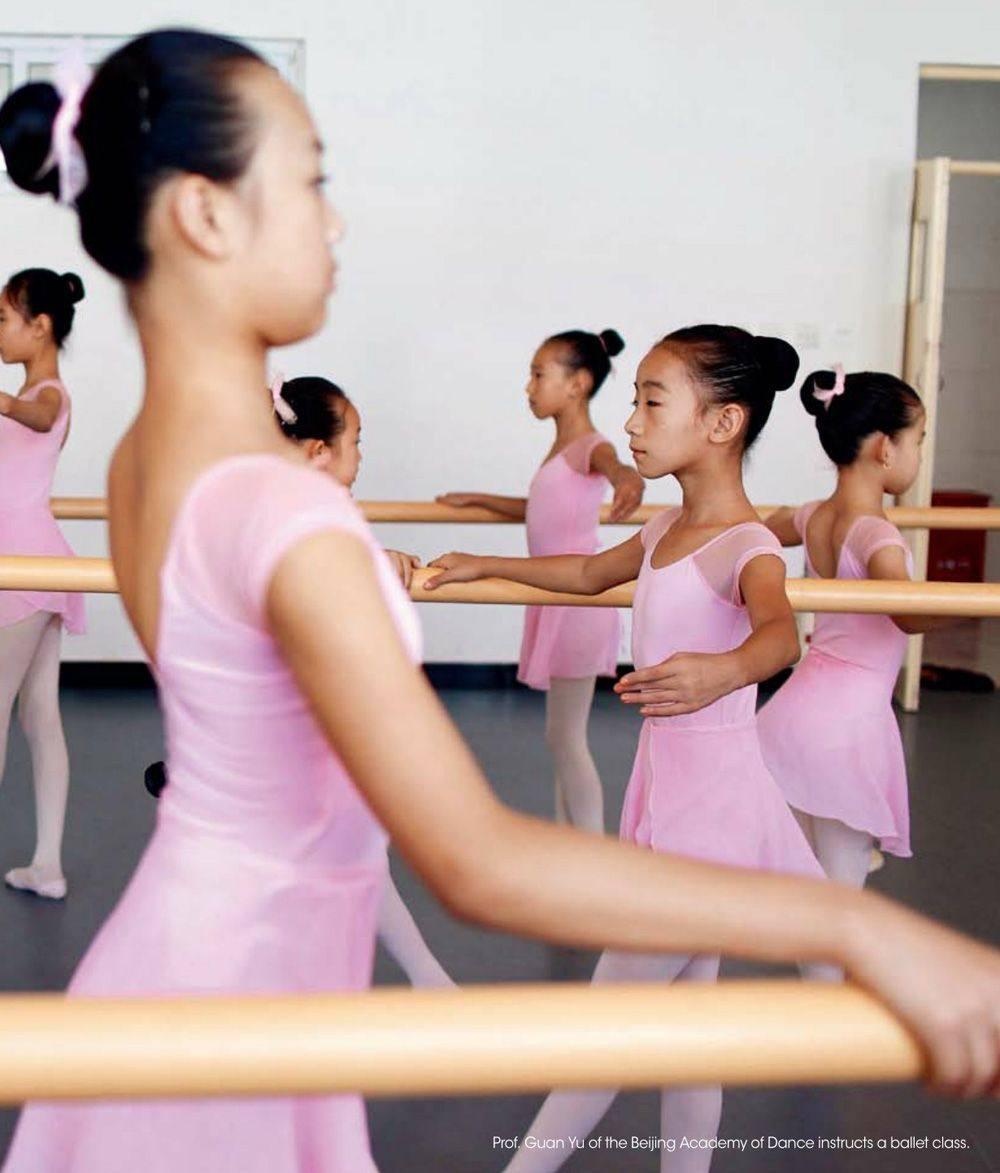The Life—Changing Power of Art Text by Zi Jian
Dressed in pink tutus, four girls raise their hands into the air, point their jaws up, and look towards the sky. Beneath their snow-white slippers lies an expansive wheat field rather than the hardwood of a dance studio.
Such a poetic scene can be found in an ordinary township on the plains of northern China. The ballerinas are elementary school students of Duancun Town in Hebei Province. Their lives were turned upside down in March 2013 when the Hefeng Art Education Program arrived.

Ballet in the Fields
Duancun Town is located on the northern shore of Baiyangdian, the largest lake on the Haihe River Plains. Consisting of several villages, its population numbers over 10,000, most of whom subsist through tourism and aquatic cultivation industries along with the cultivation of grains. The average household income in the area sits at 50,000 yuan (US$8,200) a year.
Most kids in the area spend their free time watching television or playing with friends. Although the town is only a few kilometers away from the county seat, inconvenient transportation diminishes the feasibility of enrolling in already-expensive 40-yuan-per-hour art training classes there.
A few children bid farewell to their too-plentiful leisure hours in June 2012 when 20 girls were selected as the first group of trainees for Chinas first Rural Childrens Corps de Ballet.
Guan Yu, deputy director of the Ballet Department at the Beijing Dance Academy, agreed to serve as an instructor for the program after an invitation from Li Feng, founder of the Hefeng Art Foundation. “I was dreaming of teaching underprivileged children in villages of Yunnan Province after retiring,” grins Guan, “but my dream is coming true ahead of schedule.”
Li Feng has a firm belief in ballet teaching in the countryside.“The art was developed by aristocratic classes, but performing it here will profoundly influence these childrens lives,” he explains as the reason behind establishing the foundation.
Since the late 1990s, Li Feng has traveled to Europe annually and visited its museums, art galleries, and concert halls. After delving deep into the study of art history, he made three special visits to Florence seeking answers to his burning questions.
By 2005, he was more confident in his ability to promote social development in rural China through art education and promotion. “The biggest breakthrough of our program came from thorough contemplation,” Li explains. His surveys and investigations all pointed to art education resources in rural areas severely lacking compared to urban areas. “I decided to help rural children build self-confidence and dignity through classical art and let them develop their own definitions of beauty.”
He chose his hometown, Duancun, as the starting line.
He named the foundation Hefeng. In Chinese, “he” means “lotus.” “In this context, lotus symbolizes the start of a brand-new life for children, but also connotes inspiring adults passion for art.”“Feng” means “wind.” “The power of art is invisible like wind,” Li continues. “Gusts of wind only inspire lotuses to grow larger and stronger.”


Making a Difference
Training programs started in June 2012 at the towns elementary school before the September inauguration of the art school. Along with ballet, other training programs, such as orchestral music, choir, drama, and painting, were offered. By the end of 2012, over 60 percent of local elementary school students had enrolled.
“My ultimate goals are still far away,” smiles Li Feng. “Someday in the future, I want to establish childrens choir on par with those of Vienna and San Marco.”
When selecting orchestra members in December 2012, Li Feng played From the New World by Antonin Dvorak – the first time that these children had ever heard the Western classic.
When explaining to the girls parents the reasoning behind learning ballet, Guan Yu put things in a more “practical” and acceptable way: “Every family has two or three children. Girls are expected to get married. Ballet can help them maintain good figures and temperament.”
Ballet requires a lot from the studio, but the condition of local structures was worlds away: The school lacked even a playground, and the classrooms had only worn-down wooden benches and desks. Space for a studio became a major concern.
“Some may argue that my efforts are wasted on girls from the middle of nowhere,” Guan Yu concedes. “Nevertheless, ballet can make a big difference in their lives, which can in turn enrich rural cultural life.”
Ballet class usually runs for four hours every Sunday. The local girls didnt have the habit of removing their shoes before entering the room. Guan Yu helped them, and lined up their shoes orderly outside the door. He set strict rules for the students: No nail polish is allowed. The only thing allowed in their hair is a black hairpin. Dance clothes and shoes must be neat, with no visible tears. He even spent two hours to teach the girls how to wear their hair up. “Art begins with good habits – becoming clean, neat, and graceful,” he asserts.
In recent months, students have learned two dances: Four Little Swans and Breeze of Lotus, which was specially choreographed for the class and inspired by the view of lotuses on the lake.
Guan Yu dove straight into dancing rather than began with the basic skills – the traditional way of teaching. “Once they fall in love with ballet, they will find their own motivation to practice the skills so they can perform better,” he opines.
The orchestra class began in early April. Due to space limitations, one classroom accommodates three teachers in separate corners. It lacks even a fan or electric lights. Teachers must start with musical notation since students lack any music knowledge whatsoever.
Conditions for the choir are even worse.
Meng Ziyan, an opera major at Chinas Central Conservatory of Music, serves as a volunteer teacher. “At the beginning, only three out of 30 students showed any vocal promise, and the only song anyone could sing was the national anthem,” recalls Meng.“They all had trouble staying in tune and keeping rhythm because they hardly ever listened to music,” he continues. “They would always start singing faster and faster without realizing it.”
Everyone was starting from scratch. Nevertheless, Li Feng is still very discerning with selection of teachers. The orchestra and chorus instructors were recruited from the Central Conservatory of Music, drama instructor from Beijings Central Academy of Drama, and the painting instructor is an oil painting major at Beijing Normal University. Music tutors teach right from the staff, which makes things easier to understand than numbered musical notation. In ballet class, Guan Yu uses French to describe each movement, laying a solid foundation for those who may study under foreign instructors in the future.


The inauguration ceremony of the school on September 28, 2013 presented a chance for every trainee to show what they had learned. Over 40 rural children, who previously knew little about musical instruments, played “Twinkle Twinkle Little Star” together. The drama students staged Maurice Maeterlincks Blue Bird. The painting class reproduced Claude Monets Water Lilies on 50 separate pieces of paper, which combined to make the composition six square meters big. The event showcased the abilities of every student. Guan Yu even showed his little dancers how to answer a curtain call. “I just wanted them to enjoy the applause.”
Dreams vs. Reality
On their first visit to the wharf at Baiyangdian, a middle-aged man gave Guan Yu and each teacher a bottle of mineral water without saying a word. The stranger left before anyone could even thank him.
“He is a students father who makes living selling mineral water by the wharf,” reveals Guan Yu, who previously earned over 1,000 yuan an hour teaching. “It was the slow season, so I knew it would take him a couple of days just to earn back the money he spent on this gift. He inspired me to teach with all my might.”
After class, each student is required to write in a journal. Student Wang Zheng wrote, “Ballet is gracious. I have become obsessed. The teacher told us that we should smile every day because its the best way to become a real swan.” Her life will remain changed even she doesnt continue studying dance after leaving for high school.
The innocence of rural students and desperation of their parents drive the teachers to continue pressing on. The drive between Beijing and Duancun takes more than three hours. Once a week, teachers set off at six in the morning, and return at seven.
Hefeng Art Foundation was officially founded in May 2013, with initial funds of two million yuan donated from Li Fengs own pocket. Guan Yu and the other teacher, Zhang Ping, work for free. Necessary provisions for students such as hairpins, socks, and dancing shoes are all purchased by teachers.
Li Feng specializes in investments. In his opinion, public welfare organizations should operate like businesses. “Investing is about optimizing various resources,” he illustrates. “Foundations should support education. We should optimally utilize funding, communities, and schools which can provide space for art education.” This model, however, seems to lack a mechanism to recruit a proper group of teachers. “I tried to get the best teachers I could for the money I have,” continues Li, “but my model is hard to follow in other parts of the country, because finding the perfect combination of provincial-level professional teachers and volunteers might not be that easy.”
According to plans, a 560-square-meter basement will become Duancuns art education center. The foundation invited three professional educators to teach music. When in Beijing, Li Feng invites friends from every sector to visit Duancun in hopes of drawing more attention and support. “Its no big deal for a friend to donate 1,000 yuan, with which we can buy a clarinet and three violins,” Li grins. “Perhaps more donors will emerge if we ask them to buy musical instruments directly instead of forking over cash, so they know exactly where their philanthropy is going.”




